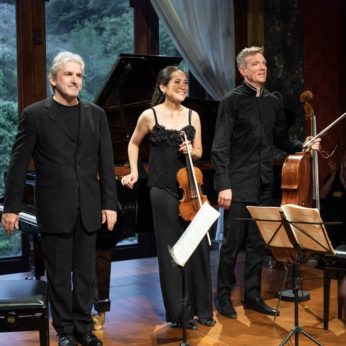Composer: Pyotr Ilyich Tchaikovsky (b. 1840 - d. 1893)
Performance date: 04/07/2019
Venue: Bantry Library
Composition Year: 1881-2
Duration: 00:49:58
Recording Engineer: Ciaran Cullen, RTÉ
Instrumentation: vn, vc, pf
Instrumentation Category:Trio
Artists:
Viviane Hagner -
[violin]
Johannes Moser -
[cello]
Barry Douglas -
[piano]

Viviane Hagner [violin], Johannes Moser [cello], Barry Douglas [piano]
Pyotr Tchaikovsky [1840-1893]
Piano Trio in A minor Op.50 ‘ To the memory of a great artist’ [1881-2]
1. Pezzo elegiaco: Moderato assai – Allegro giusto
2. Tema con variazioni
Tema – Andante con moto
Var:1 – Cantabile
Var:2 – Più mosso
Var:3 – Allegro moderato
Var:4 – L’istesso tempo
Var:5 – L’istesso tempo
Var:6 – Tempo di valse
Var:7 – Allegro moderato
Var:8 – Fuga: Allegro moderato
Var:9 – Andante flebile, ma non tanto
Var:10 – Tempo di mazurka
Var:11 – Moderato
3. Variazione finale e Coda – Allegro risoluto e con fuoco
Tchaikovsky wrote this overwhelming Trio in memory of his old friend and mentor, Nikolai Rubinstein, who had died suddenly at a young age. Rubinstein had been Director of the Moscow Conservatoire as well as a famous pianist and composer and had been a major force in Russian musical life.
Elegiac works in the Russian tradition tend to be massive and this one is no exception. We are immediately struck by the breath-taking lyricism of the main theme that the cello announces before passing it to the violin and eventually the piano. The second theme is a complete contrast, Russian in style and in the nature of a triumphant song celebrating Rubinstein’s remarkable achievements, which is then given an elaborate and lengthy working out, leading eventually to a beautiful new idea that flows from the violin through the trio. Happy memories are eventually put aside at the solemn return of the opening theme, which is built up into a long elegiac peroration befitting such a vital figure in Russian music.
A second instantly memorable theme opens the mighty set of variations that makes up the second movement. The variations are thought to recall Rubinstein’s personality and incidents in his long friendship with Tchaikovsky. The theme is announced first on the piano and then picked up unaltered by the violin before it is slipped into ¾ time and mazurka-style. The third variation is a miniature scherzo starring the piano with unusual comments from the strings. This is followed by a leisurely and expansive
Russian dance based on the second part of the theme, while the fifth variation features the piano in delicate music-box style. Next comes a dainty waltz that is gratefully allowed to spread out into one of the longest variations. Number seven sees the theme in the piano in broad chords while the strings answer in their own style. Next is a delightful fugue, vigorous and full of fun, dancing and laughing all at once. The ninth reverts to a muted and mournful style, whereas in the mazurka tenth Tchaikovsky once more pays tribute to Rubinstein’s pianism leading directly into the violin bringing back the original theme.
The Finale opens with a burst of long-repressed energy that flares up dramatically,
collecting a version of the variations theme in its tumultuous path and triumphantly celebrating Rubinstein’s life before recalling the elegiac theme of the opening movement. This is the signal for an evocative and impressive funeral march that sinks finally into an appalled coda.
Francis Humphrys
Copyright © 2024 West Cork Music. All rights reserved.
Designed and developed by Matrix Internet